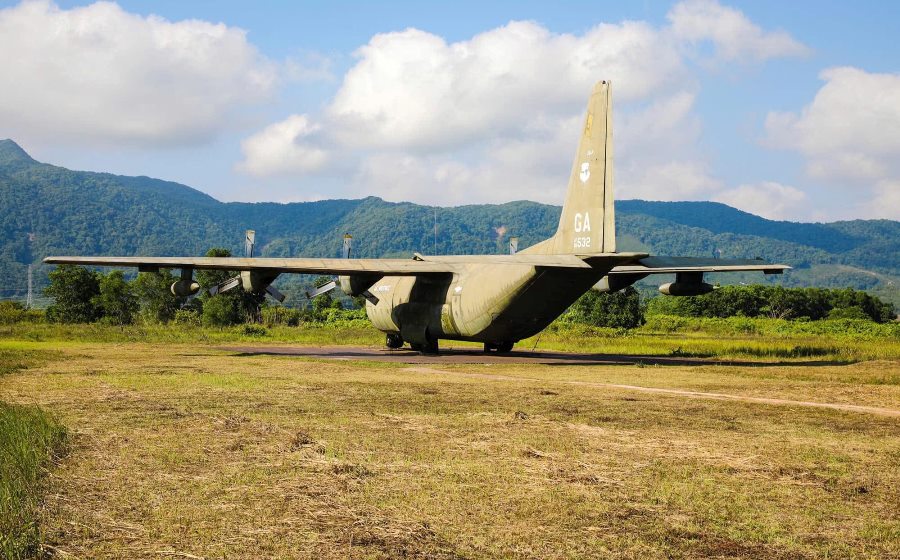Introduction
Khe Sanh Combat Base is one of the most historically significant military sites from the Vietnam War. Located in the rugged hills of Quang Tri Province in Central Vietnam.
This former U.S. Marine Corps outpost became globally known during the 1968 Battle of Khe Sanh, one of the longest and bloodiest battles of the Vietnam War.
Today, it serves as a haunting reminder of the war and a powerful destination for history lovers and veterans.
Khe Sanh Combat Base Location
Ta Con Air Base is located near the town of Huong Hoa, approximately 63 kilometers west of Dong Ha city and close to the Laos border.
It sits along the historic Ho Chi Minh Trail and was a key strategic point during the war. Its remote mountainous location gave the base both defensive advantages and logistical challenges.
You may need our Vietnam Private Cars, Vietnam Tours to visit the Vietnam DMZ relics, such as
- Hue to Vinh Moc Tunnels private car– from 65 USD/ Sedan.
- Hoi An to Vinh Moc Tunnels by car– from 152 USD/ Sedan.
- Da Nang to DMZ private car– from/ 140 USD/ Sedan.
- Best DMZ Tour Hue– from 31 USD/ Pax.
Khe Sanh Combat Base History
Established in 1962 by U.S. Special Forces and later expanded by the U.S. Marines, Khe Sanh Combat Base played a central role in the American strategy to block the North Vietnamese Army’s supply routes into South Vietnam.
The base became world-famous during the 77-day siege from January to April 1968, when more than 6,000 U.S. Marines and allied troops withstood a massive assault from over 20,000 North Vietnamese troops.
The battle coincided with the Tet Offensive, which marked a turning point in public opinion about the war.
Names of Marines at Khe Sanh
Thousands of Marines served at Khe Sanh, including the renowned 1st Battalion, 9th Marines (1/9), nicknamed “The Walking Dead” due to their heavy casualties.
While there is no single official list available at the site, many veterans’ groups and memorial projects in the U.S. have compiled names of Marines at Khe Sanh who served or died during the siege. These names live on through online memorials and reunions held by veteran associations.
Khe Sanh Hill Fights
Before the siege in 1968, several intense battles occurred around the surrounding high ground, known as the Khe Sanh Hill Fights. Notable hills included Hill 881 North, Hill 861, and Hill 950. These positions were crucial for controlling movement in and out of the base and saw fierce fighting between U.S. forces and the North Vietnamese Army. These hill fights were a grim prelude to the full-scale siege that followed.
Khe Sanh Combat Base, Vietnam War
During the Vietnam War, this Combat Base symbolized American military resilience but also the controversy surrounding the war.
The battle’s massive scale, high casualties, and strategic ambiguity left many questioning its value. The base was eventually abandoned just months after the siege ended, which added to the debate over U.S. war policies. Today, it stands as a symbol of courage and the complex legacy of the Vietnam War.
1/9 Marines Khe Sanh
The 1/9 Marines were one of the most famous units to serve at Khe Sanh. Their nickname, “The Walking Dead,” reflected the high risk and extreme conditions they faced during the siege.

These brave men endured continuous shelling, limited supplies, and close-quarters combat. Their story is remembered with deep respect by the Marine Corps and military historians alike.
Khe Sanh Combat Base Map
The layout of the original Khe Sanh base included airstrips, bunkers, artillery positions, and living quarters surrounded by red clay hills. Visitors today can explore the site using a Khe Sanh Combat Base map, which outlines key areas like the runway, the museum, trenches, and remnants of American aircraft.
Many historical maps are available at the site or online, helping visitors understand the scale and complexity of the base.
Khe Sanh Combat Base Today
Today, Khe Sanh is a peaceful and quiet destination, with lush green hills replacing the once war-torn landscape. The base has been partially preserved and turned into a historical site, offering visitors a chance to walk the grounds, view artifacts, and pay respects to those who fought there.
Although some structures are reconstructions, they provide a realistic sense of what life was like for the soldiers stationed here.
Khe Sanh Combat Base Museum
The Khe Sanh Museum, located on the former base grounds, showcases a collection of war memorabilia, including American helicopters, tanks, weapons, photographs, and personal belongings of soldiers.
Informative panels explain the history of the base and the battles that occurred. The museum offers a moving and educational experience for visitors seeking to understand the human cost and strategic importance of this location.
Khe Sanh Combat Base Photos
Khe Sanh Combat Base photos capture the stark contrast between the past and present. Wartime images show devastated terrain, military hardware, and intense combat conditions, while modern photos display a serene, almost surreal landscape.
Tourists often share images of rusted helicopters, reconstructed bunkers, and the museum displays. These photos help tell the story of resilience, sacrifice, and transformation.
Khe Sanh Combat Base Tour
A Khe Sanh Combat Base tour is an unforgettable experience for travelers exploring the DMZ (Demilitarized Zone) in Vietnam. Tours often depart from Dong Ha, Hue, or Phong Nha and include other war-related sites such as the Vinh Moc Tunnels and Truong Son Cemetery.
A knowledgeable guide brings the history to life, sharing personal stories, battle strategies, and historical context. Tours typically include transport, museum entry, and time to walk the grounds and reflect.









